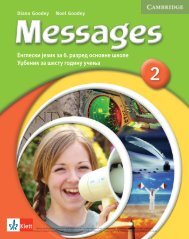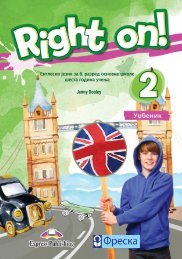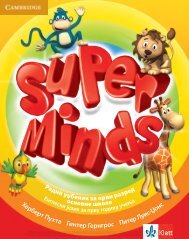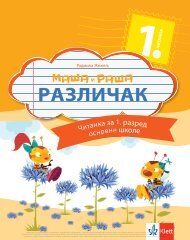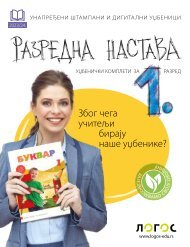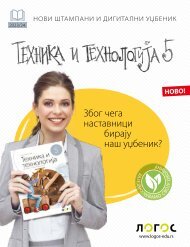Енглески језик 8, уџбеник, старо издање, Нови Логос
- No tags were found...
You also want an ePaper? Increase the reach of your titles
YUMPU automatically turns print PDFs into web optimized ePapers that Google loves.
English Plus Options<br />
CURRICULUM EXTRA Physics and chemistry: Satellites and spacecraft<br />
I can talk about the future of space travel and exploration.<br />
4<br />
A<br />
C<br />
1 Check the meaning of the words in the box.<br />
Then match them with A–E in the photos.<br />
space station weightlessness<br />
space shuttle Earth satellite<br />
2 2.20 Complete the text with the words in<br />
exercise 1. Then read and listen to the text and<br />
check.<br />
3 Read the text again and write true or false.<br />
Correct the false sentences.<br />
1 The Soviet Union put the first artificial<br />
satellite in orbit.<br />
2 Sputnik 1 was the first natural satellite.<br />
3 Astronauts constructed the ISS in space.<br />
4 Teams of researchers have been living in<br />
space since 1990.<br />
5 Charles Simonyi has been on one trip into<br />
space.<br />
6 Sub-orbital spacecraft are spaceships which<br />
travel into space.<br />
7 People can experience weightlessness on<br />
sub-orbital spacecraft.<br />
B<br />
D<br />
E<br />
Out of this world<br />
A 1 is an object that orbits another object in space.<br />
There are natural satellites like the moon, which<br />
orbits 2 , and there are also artificial satellites.<br />
Artificial satellites are man-made objects which are<br />
sent into space. In 1957, the Soviet Union launched<br />
the first artificial satellite, Sputnik 1, and today there<br />
are about three thousand artificial satellites in orbit<br />
around Earth. We use them to transmit phone calls<br />
and TV signals across the world, to navigate journeys,<br />
to forecast the weather, and to study the universe.<br />
The largest artificial satellite in orbit is the<br />
International 3 or ISS. The American 4 started<br />
taking material into space to build the ISS there in<br />
the late 1990s, and different teams of researchers<br />
have lived there continuously since November 2000.<br />
The ISS was also the destination of the world’s first<br />
space tourists. One of them, the Hungarian-American<br />
billionaire Charles Simonyi, enjoyed the visit so much<br />
that he paid $35 million for a second trip. During his<br />
visits to space, he helped with research projects and<br />
chatted to schoolchildren in the USA via a video link.<br />
Space tourism will be more popular in the future,<br />
thanks to the development of sub-orbital spacecraft.<br />
Travelling to altitudes of over one hundred kilometres,<br />
these craft reach the boundaries of space, at the edge<br />
of the Earth’s atmosphere. From there, passengers get<br />
a breathtaking view of Earth, and can also experience<br />
5<br />
. Prices started at $200,000 for a three-hour trip,<br />
but flights will certainly become cheaper in the future.<br />
Scientists hope that the increase in space tourism will<br />
help to raise money to fund further space projects.<br />
4 ACTIVATE Read sentences 1–6. Work in pairs<br />
and discuss whether you think these things<br />
are already possible, will be possible in the<br />
future, or will never be possible.<br />
1 Hotels will open in space.<br />
2 Tourists will be able to visit other planets.<br />
3 People will have their own personal space<br />
shuttle.<br />
4 People will be able to experience<br />
weightlessness in their own home.<br />
5 People will grow plants in space.<br />
6 There will be budget flights to the moon<br />
costing about €100.<br />
Curriculum extra 99<br />
Property of Oxford University Press. Provided for and restricted to creating accessible formats for users with a disability.



